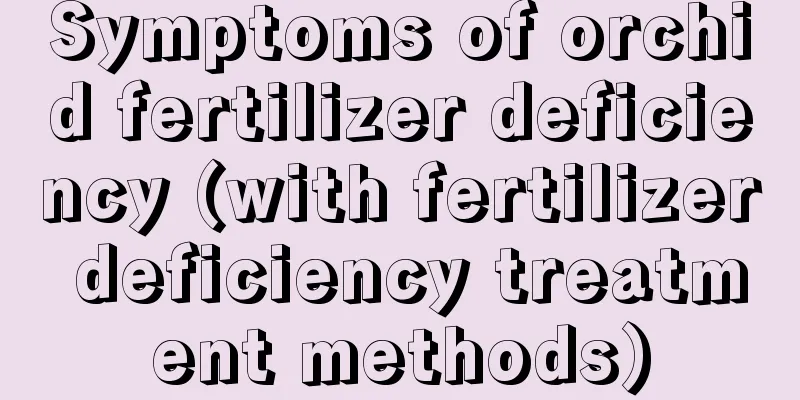Symptoms of orchid fertilizer deficiency (with fertilizer deficiency treatment methods)

1. Symptoms of Fertilizer Deficiency1. Nitrogen deficiency: Nitrogen can promote the growth of orchid leaves. When nitrogen is deficient, the plant will have problems such as new leaves growing poorly, being thinner than old leaves, and having dull color and luster. 2. Phosphorus deficiency: Phosphorus fertilizer can promote the germination and growth of orchid leaf buds. When the leaf buds of the plant grow slowly and the leaf edges curl, it means that the plant may be lacking in phosphorus. 3. Magnesium deficiency: Magnesium is an important element for the synthesis of chlorophyll. When orchids lack magnesium, their chlorophyll will decrease and the leaves will turn yellow. 4. Potassium deficiency: leaf edges and tips turn yellow. First, the old leaves turn yellow, and gradually the new leaves also begin to turn yellow, and then from yellow to brown. In addition, the leaves of the plant will become softer and easier to droop. If exposed to strong light or low temperatures, the leaves will become dehydrated. 5. Calcium deficiency: The leaves will change shape, affecting the appearance of the plant. II. Solutions1. Nitrogen deficiency: Irrigate the roots with potassium sulfate compound fertilizer solution, and the plant will slowly recover. Or you can spray urea solution on the leaves in the evening, once every three to five days. Repeat three times and the new leaves will return to normal. 2. Phosphorus deficiency: You can use potassium phosphate solution to irrigate the roots once every ten days, and the condition will improve after two times. Or you can spray it directly on the leaves. Spraying foliar fertilizer will be effective faster. Apply it once every three days, and the condition will improve after three times. 3. Magnesium deficiency: In the evening, spray 0.5% magnesium sulfate solution on the orchid leaves. Spray once every three to five days, and spray three to five times in a row to solve the problem. 4. Potassium deficiency: Use 0.5% potassium sulfate solution to water the roots and spray the leaves, and you can also sprinkle some wood ash. 5. Calcium deficiency: You can solve the problem of calcium deficiency in orchids by irrigating the roots with 1% lime solution once. |
<<: Is compound fertilizer effective for orchids? How to apply compound fertilizer
>>: Can orchids use bean cake fertilizer? How to apply cake fertilizer to orchids
Recommend
Cultivation methods and precautions of golden dew flower
Golden dew flower is relatively easy to grow. If ...
How to judge whether orchids are lacking water and whether to water them
1. Observe the leaves Orchids need reasonable wat...
Common Poinsettia Varieties
White The first white violet was discovered in 19...
Not only Chlorophytum comosum can be grown hangingly! These 10 kinds of succulents are so beautiful when hung!
Buddhist beads The name of Buddhist beads is just...
How to prune the rich tree
How to prune the branches of the rich tree The ri...
Four-season maintenance methods of Staghorn Begonia
Spring maintenance methods for Staghorn Begonia R...
Do dandelions prefer shade or sun?
Do dandelions prefer shade or sun? Dandelions are...
Can Clivia survive if its roots are cut?
Can Clivia survive if its roots are cut off? When...
How to grow dahlias
Soil selection for dahlias Dahlias grow best in l...
Which red rose variety is easy to grow and worth planting (recommended red large-flowered rose varieties)
Red Apple Rose (Picture) Which bright red rose is...
How to plant sweet potatoes in pots when they sprout? How often should I change the water?
Sweet potatoes often sprout before we can eat the...
Are you always worried about not being able to grow “Asparagus Fern”? It’s not that difficult. If you fertilize well, asparagus fern can also grow green!
Many people also like asparagus fern, but because...
What is the best month to plant blueberries?
When it comes to fruits that protect the eyes, th...
The difference between Prunus mume and Prunus mume
Different leaves The petiole of Prunus mume is sh...
How to grow soybean sprouts
1. Choose soybean varieties When selecting seeds,...









